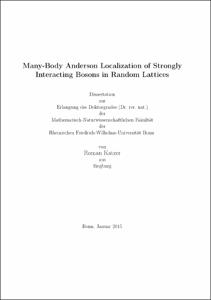Many-Body Anderson Localization of Strongly Interacting Bosons in Random Lattices

Many-Body Anderson Localization of Strongly Interacting Bosons in Random Lattices

| dc.contributor.advisor | Kroha, Johann | |
| dc.contributor.author | Katzer, Roman | |
| dc.date.accessioned | 2020-04-21T06:06:36Z | |
| dc.date.available | 2020-04-21T06:06:36Z | |
| dc.date.issued | 27.05.2015 | |
| dc.identifier.uri | https://hdl.handle.net/20.500.11811/6471 | |
| dc.description.abstract | In the present work, we investigate the problem of many-body localization of strongly interacting bosons in random lattices within the disordered Bose-Hubbard model. This involves treating both the local Mott-Hubbard physics as well as the non-local quantum interference processes, which give rise to the phenomenon of Anderson localization, within the same theory. In order to determine the interaction induced transition to the Mott insulator phase, it is necessary to treat the local particle interaction exactly. Therefore, here we use a mean-field approach that approximates only the kinetic term of the Hamiltonian. This way, the full problem of interacting bosons on a random lattice is reduced to a local problem of a single site coupled to a particle bath, which has to be solved self-consistently. In accordance to previous works, we find that a finite disorder width leads to a reduced size of the Mott insulating regions. The transition from the superfluid phase to the Bose glass phase is driven by the non-local effect of Anderson localization. In order to describe this transition, one needs to work within a theory that is non-local as well. Therefore, here we introduce a new approach to the problem. Based on the results for the local excitation spectrum obtained within the mean-field theory, we reduce the full, interacting model to an effective, non-interacting model by applying a truncation scheme to the Hilbert space. Evaluating the long-ranged current density within this approximation, we identify the transition from the Bose glass to the superfluid phase with the Anderson transition of the effective model. Resolving this transition using the self-consistent theory of localization, we obtain the full phase diagram of the disordered Bose-Hubbard model in the regime of strong interaction and larger disorder. In accordance to the theorem of inclusions, we find that the Mott insulator and the superfluid phase are always separated by the compressible, but insulating Bose glass phase. | en |
| dc.language.iso | eng | |
| dc.rights | In Copyright | |
| dc.rights.uri | http://rightsstatements.org/vocab/InC/1.0/ | |
| dc.subject | Vielteilchentheorie | |
| dc.subject | Gittermodell | |
| dc.subject | Ungeordnetes System | |
| dc.subject | Wechselwirkung | |
| dc.subject | Metall-Isolator-Übergang | |
| dc.subject | Anderson-Lokalisierung | |
| dc.subject | Suprafluidität | |
| dc.subject.ddc | 530 Physik | |
| dc.title | Many-Body Anderson Localization of Strongly Interacting Bosons in Random Lattices | |
| dc.type | Dissertation oder Habilitation | |
| dc.publisher.name | Universitäts- und Landesbibliothek Bonn | |
| dc.publisher.location | Bonn | |
| dc.rights.accessRights | openAccess | |
| dc.identifier.urn | https://nbn-resolving.org/urn:nbn:de:hbz:5n-40176 | |
| ulbbn.pubtype | Erstveröffentlichung | |
| ulbbnediss.affiliation.name | Rheinische Friedrich-Wilhelms-Universität Bonn | |
| ulbbnediss.affiliation.location | Bonn | |
| ulbbnediss.thesis.level | Dissertation | |
| ulbbnediss.dissID | 4017 | |
| ulbbnediss.date.accepted | 12.05.2015 | |
| ulbbnediss.institute | Mathematisch-Naturwissenschaftliche Fakultät : Fachgruppe Physik/Astronomie / Physikalisches Institut (PI) | |
| ulbbnediss.fakultaet | Mathematisch-Naturwissenschaftliche Fakultät | |
| dc.contributor.coReferee | Kollath, Corinna |
Files in this item
This item appears in the following Collection(s)
-
E-Dissertationen (4337)




